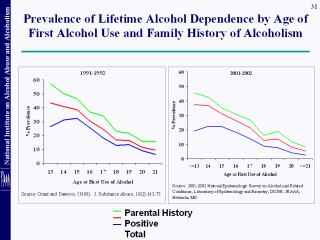Search for most updated materials ↑
| front |1 |2 |3 |4 |5 |6 |7 |8 |9 |10 |11 |12 |13 |14 |15 |16 |17 |18 |19 |20 |21 |22 |23 |24 |25 |26 |27 |28 |29 |30 |31 |32 |33 |34 |35 |36 |37 |38 |39 |40 |41 |42 |review |
 |
Some of the first evidence of the
importance of the lifespan perspective for understanding alcohol use
disorders emerged less than ten years ago in an analysis of data
derived from NIAAA’s National Longitudinal Alcohol Epidemiologic
Study (NLAES). This analysis indicated that persons who begin
drinking at younger ages have a significantly increased risk for the
development of alcoholism. This finding was replicated in the recent
NESARC study, as shown in this slide. These data show that young
people who begin drinking before age 15 were four times more likely
to develop alcohol dependence during their lifetime than those who
begin drinking at age 21. This is true for individuals from
families where a parent had a history of alcoholism (Parental
History Positive) and for individuals with no parental history of
alcoholism (Parental History Negative). Therefore, while parental
history clearly contributes to the risk for developing alcoholism,
likely a reflection of genetic risk factors, early initiation of
drinking is also an important predictor of risk for the eventual
development of alcoholism.
|